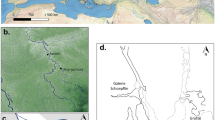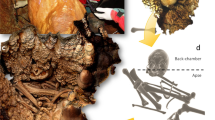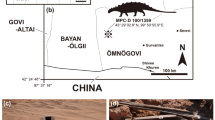A remarkable discovery in a French museum answers some long-standing questions.
Abstract
Fossil remains of adult Neanderthals are well documented, but juvenile specimens are rare and information about them is scant. Here we identify a beautifully preserved skeleton that has been lost to science for almost 90 years as the Neanderthal neonate known as 'Le Moustier 2', which was originally found at Le Moustier in the Dordogne, southwest France. This find will be a rich source of data for studying the evolution of human ontogeny1 as well as the phylogenetic relationship between these extinct hominids and anatomically modern humans.
This is a preview of subscription content, access via your institution
Access options
Subscribe to this journal
Receive 51 print issues and online access
$199.00 per year
only $3.90 per issue
Buy this article
- Purchase on Springer Link
- Instant access to full article PDF
Prices may be subject to local taxes which are calculated during checkout

JUGIE/MUSÉE NATIONAL DE PRÉHISTOIRE
Similar content being viewed by others
References
Ponce de Léon, M. S. & Zollikofer, C. P. E. Nature 412, 534–538 (2001).
Peyrony, D. Rev. d'Anthropol. 40, 48–76, 155–176 (1930).
Peyrony, D. Les Moustériens Inhumaient: Ils Leurs Morts? (Ribes, Périgueux, 1921).
Valladas, H. et al. Nature 322, 452–454 (1986).
Heim, J.-L Les Hommes Fossiles de La Ferrassie Vol. 1 (Masson, Paris, 1976).
Sellier, P., Tillier, A.-M & Bruzek, J. Am. J. Phys. Anthropol. 22 (suppl.), 208 (1997).
Heim, J.-L. Les Enfants Néandertaliens de La Ferrassie (Masson, Paris, 1982).
Maureille, B. La face chez Homo erectus et Homo sapiens: Recherche sur la variabilité morphologique et métrique. Thesis, Univ. Bordeaux 1, France (1994).
Maureille, B. & Bar, D. J. Hum. Evol. 37, 137–152 (1999).
Dodo, Y., Kondo, O., Muhesen, S. & Akasawa, T. in Neanderthals and Modern Humans in Western Asia (eds Akasawa, T., Aoki, K. & Bar-Yosef, O.) 323–338 (Plenum, New York, 1998).
Trinkaus, E. The Shanidar Neanderthals (Academic, New York, 1983).
Patte E. La Dentition des Néandertaliens (Masson, Paris, 1962).
Krings, M. et al. Nature Genet. 26, 144–146 (2000).
Author information
Authors and Affiliations
Corresponding author
Ethics declarations
Competing interests
The author declares no competing financial interests.
Rights and permissions
About this article
Cite this article
Maureille, B. A lost Neanderthal neonate found. Nature 419, 33–34 (2002). https://doi.org/10.1038/419033a
Issue Date:
DOI: https://doi.org/10.1038/419033a
This article is cited by
-
Anatomically modern human in the Châtelperronian hominin collection from the Grotte du Renne (Arcy-sur-Cure, Northeast France)
Scientific Reports (2023)
-
Pluridisciplinary evidence for burial for the La Ferrassie 8 Neandertal child
Scientific Reports (2020)
-
The Fetal Origin of the Human Chin
Evolutionary Biology (2017)
-
The presacral spine of the La Ferrassie 1 Neandertal: a revised inventory
Bulletins et mémoires de la Société d'anthropologie de Paris (2013)
-
Fossil infant skeleton could shed light on hominid development.
Nature (2002)
Comments
By submitting a comment you agree to abide by our Terms and Community Guidelines. If you find something abusive or that does not comply with our terms or guidelines please flag it as inappropriate.



